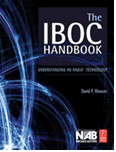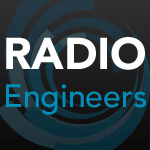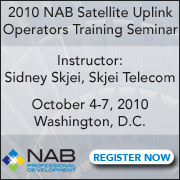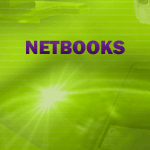
|
Radio-Ready Cell Phone Showcase at the Radio Show Including radio
functionality in a cellular phone is easily done, and in fact hundreds
of millions of cell phones have been made with FM radio (sold mostly
outside of the U.S.). At this week’s Radio Show (September
29–October 1, 2010, Washington, D.C. www.radioshowweb.com),
an exhibit in the lobby will highlight this fact and include examples
of phones that have radio functionality, as well as information
on devices which facilitate easy and affordable inclusion of embedded
FM radio antennas. The primary components needed to include an FM radio in a cell phone include a tiny FM receiver integrated circuit (IC) or “chip” (which typically measures about 3mm on a side) and an FM antenna.FM receiver functionality is also often incorporated into the ICs that many cell phones already have for supporting wireless Bluetooth and WiFi capabilities, and in these instances the only additional requirement to make these phones FM-capable would be the inclusion of the FM antenna (plus some additional software for providing a user interface to the radio feature). In most current phones with FM radio, the headset cord that is used for listening to the audio also doubles as the FM antenna, however a more elegant solution is to embed the antenna within the case of the cell phone itself. Both the Nokia 5030 and the Motorola ROKR EM35 have embedded FM antennas. However, neither of these GSM phones is currently offered by any U.S. cellular carrier. 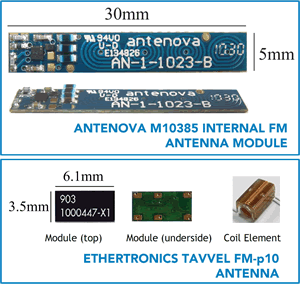
Three embedded antenna manufacturers – Antenova (Cambridge, U.K., www.antenova.com), Ethertronics (San Diego, Calif., www.ethertronics.com), and The Technology Partnership (TTP, Melbourn, U.K., www.ttp.com) – will have posters and literature at The Radio-Ready Cell Phone Showcase describing their embedded antenna technology. Two of these vendors (TTP and Ethertronics) are currently developing advanced embedded antenna designs for handheld FM radio and mobile DTV (low-and high-VHF and UHF frequencies) applications with funding from the NAB FASTROAD technology advocacy program (www.nabfastroad.org). At the Showcase, Antenova and Ethertronics are highlighting the following off-the-shelf antenna products:
Also at the Showcase, Global Security Systems (GSS, Jackson, Miss., www.gssnet.us), manufacturer of the Alert FM radio-based alert system, will be on hand to highlight radio’s emergency alerting capabilities, including FM-based Radio Data System (RDS) text messaging and audio alerts, that demonstrate the power of radio to keep citizens informed in times of crisis. Even when cellular networks are overloaded, radio's reach can provide lifesaving information on the proven and effective broadcast network when a cell phone is equipped with a functioning radio chip. Just last week, GSS and Sage Alerting Systems, manufacturer of broadcast alerting equipment (Rye Brook, N.Y., www.sagealertingsystems.com), announced a cooperative agreement that advances the common alerting protocol (CAP)-based Emergency Alert System (EAS) for radio broadcasters, and according to their press release, meets Integrated Public Alert and Warning System (IPAWS) Open Infrastructure requirements. The Sage Digital Endec, the GSSNet satellite delivery network, and CAP origination tools provide a complete end-to-end CAP source, transport, and broadcast dissemination system. The combined benefits include addressable satellite delivery of CAP-originated EAS audio and EAS text messages for all radio broadcasters, and dissemination of first-generation digital audio and text for display on any FM receiver with RDS, as well as being HD Radio-compatible. Geo-targeted emergency information, including National Weather Service, local, state and federal messages can be supported by this system. Alert FM receivers can also be added to the system to provide text and audio delivery with sounders and flashing lights for disabled, elderly, home and business use. A regional installation in Texas will be the first to take advantage of the GSS-Sage partnership. The installation will provide individual data-delivery to each transmitter site and mitigate the risks associated with daisy-chain and Internet systems.Pilot programs in other states will soon provide a state-wide implementation utilizing the Sage and GSSNet infrastructure.The complete GSS press release is available on their website at http://blog.alertfm.com/post/2010/09/GSS-and-Sage-Alerting-Advance-EAS.aspx. NAB
FASTROAD Report On U.S. Sales of Radio-Enabled Cell Phones Prepared by The Insight Research Corporation (Mountain Lakes, N.J., www.insight-corp.com), this report, entitled “Study of FM Radio-Enabled Handsets in the U.S.” notes that a previous FASTROAD study conducted in May 2008 by Dr. Joseph S. Kraemer, Director, Law and Economics Consulting Group, estimated that eight percent of wireless devices shipped in 2007 had an FM chip installed.Insight Research states that the findings of the current study are consistent with these earlier results because the percentage of handsets with chips installed (the benchmark used in the earlier study) will be higher than the percentage sold (the benchmark of the current study) because of the fact that some carriers disable this chip.
Insight Research
developed the statistics in the new FASTROAD report by:
Further, their research revealed that consumers often have trouble accessing the FM radio feature even when their existing device has it. Insight states that this is consistent with the fact that many carriers neither promote the feature during the sales process nor provide instructions on use during post-sale support. Most cell phones require an FM antenna in order for the FM radio feature to appear in the device menu. The consumer must plug in a pair of headphones which will act as the antenna. Users that rely on a Bluetooth earpiece will not have the correct antenna attached to the cell phone.In many cases, the headphones are an additional accessory that is not included with the device and must be purchased separately. Unless the consumer purchases the headphones and attaches them to the device, they may never see that the FM radio feature is available. Both the just-released Insight Research report and the May 2008 Kraemer report are available for download free-of-charge from the FASTROAD website. |
|
Spaces
Still Available for NAB's 2010 Satellite Uplink Operators Plan
to Attend Keynote speakers
for this year's symposium include James Martin, Director, ISR Programs
for the U.S. Department of Defense and James O'Neal, Technology
Editor, TV Technology, USA. Additional details on the technical
program and how to register
are availale on the IEEE Broadcast Technology Symposium website.
The advance registration deadline is October 1! Submit
Your Proposal Now In order to be considered, proposals must explain what attendees can expect to learn from the paper, must not be a sales pitch, and should be no more than 200 words in length. Papers accepted for presentation at the 2011 NAB Broadcast Engineering Conference will be eligible for the NAB Best Paper Award. Established in 2010, the Best Paper Award honors the author(s) of a paper of exceptional merit published in the NAB Broadcast Engineering Conference Proceedings. The yearly proceedings, published as both a book and a CD-ROM is a compendium of these technical papers, and an important archive of the leading edge of broadcast engineering issues. Technical paper
proposals submitted for the 65th annual Broadcast
Engineering Conference will be accepted until the October 22
deadline. If you have any questions, contact John
Marino, VP NAB Science and Technology at (202) 429-5346.
The September 27, 2010 Radio TechCheck is also available in an Adobe Acrobat file. Please click here to read the Adobe Acrobat version of Radio TechCheck |
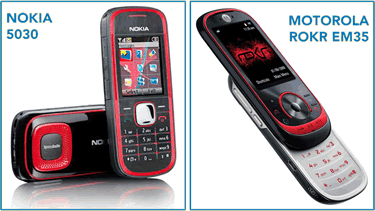 The
Radio-Ready Cell Phone Showcase will be located on the Constitution
level of the Grand Hyatt, right next to the escalator leading down
to the Renaissance level, which is where the Radio Show Marketplace
and session rooms are located.Phones on display with FM radio will
include the Nokia 5030 and the Motorola ROKR EM35 (shown in the
photos at right) as well as phones from Samsung and Sony Ericsson.
The
Radio-Ready Cell Phone Showcase will be located on the Constitution
level of the Grand Hyatt, right next to the escalator leading down
to the Renaissance level, which is where the Radio Show Marketplace
and session rooms are located.Phones on display with FM radio will
include the Nokia 5030 and the Motorola ROKR EM35 (shown in the
photos at right) as well as phones from Samsung and Sony Ericsson. A
report released last week by NAB’s technology advocacy program,
FASTROAD (Flexible Advanced Services for Television and Radio on
All Devices,
A
report released last week by NAB’s technology advocacy program,
FASTROAD (Flexible Advanced Services for Television and Radio on
All Devices, 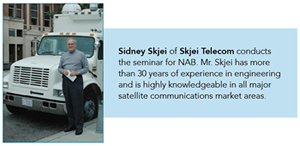 In
just four days, NAB will teach you the skills necessary for the
proper operation of the satellite uplinks. Now certified by the
In
just four days, NAB will teach you the skills necessary for the
proper operation of the satellite uplinks. Now certified by the
